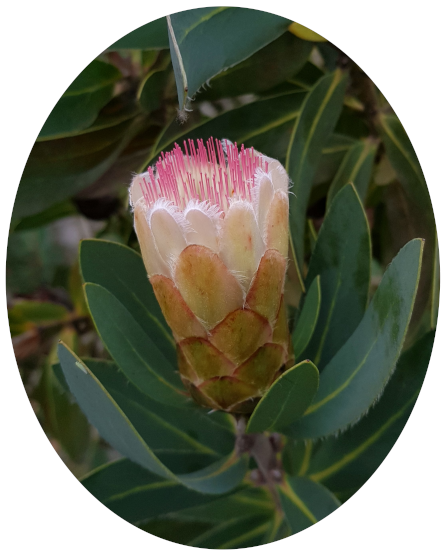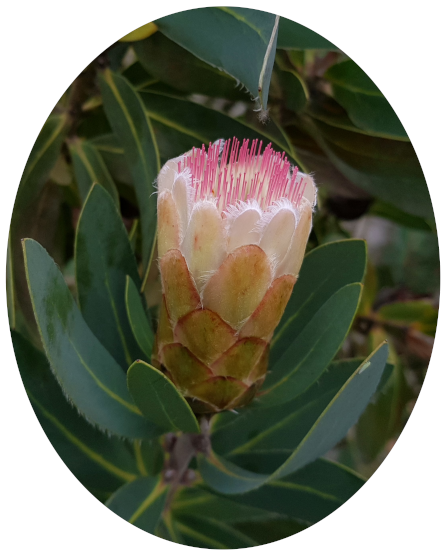
|
Rob Dempster
Protea Gardens (PG) Howick (uMngeni) PG Blog Channeling Solar More Questions than Answers 23 April 2023 Updated: 3 May 2023 |

|
Our Protea Garden's Unit is fitted with six SM 545WP Canadian Solar Panels, a Luxpower SNA5000 WPV 5 kW 48V Inverter, and a Dyness 5.1kW LiFePO4 Battery. The work was done by Utilty Africa. The Panels are positioned such that the inclination angle is P degrees relative to the horizontal and they face 47 degrees North of East. The Inverter has a small display (Figure 1) and it can be controlled/setup using buttons positioned below the small display. We can also access the Inverter by means of a cellphone app and this is how we control (setup) the inverter and receive feedback regarding how well the system is performing.
Our goals:
- If there is enough Solar Power to meet our needs:
- channel as much Solar Power into our home for immediate use as we can.
- use any excess Solar Power to charge the battery.
- one day sell any Solar Power that is surplus to 1 and 2 above, to ESKOM.
- If there is not enough Solar Power to meet our needs:
- power will be drawn from the battery provided its charged capacity is above 30%
- power from ESKOM (when it is available ;-) will make up the deficit.
- If the weather the next day is going to be cloudy
- we use ESKOM in the evening to top-up the battery.
So where are we?
- We currently cannot sell power to ESKOM, and the chances of that happening are small.
- We cannot automatically evaluate the state (charge) of the battery at the end of a day in order to determine:
- whether we have enough power in the battery to get through the night, and therefore do not have to use ESKOM to boost the battery.
- whether the next days promised sunny weather will allow us to use the battery until the sun starts to suplly sufficient power to charge the battery and supply the power required during the day.
So what do we need?
- National, Provincial and Local Government to make it possible for domestic power producers to sell/give power to the ESKOM.
- Smarter inverters that make use of weather forecasts to allow domestic and other independent Solar Power Producers to better manage their systems.
Screenshots of feedback provided by the phone app:
The first shows the Solar Yield, Battery Charge, Feed-In Energy and Consumption together with a schematic of the System. Unfortunately the energy flow at the time the screenshot was captured is shown by animated yellow arrows that are difficult to see. I added the solid arrows. The graph illustrating charging a flat battery (20%) on a sunny day on which we don't use much electricity, will probably afford the best illustration (and estimate) of the electrical power the Solar Panels are bringing to the system.
The second uses graphs to show the electricity production, storage and consumption for the day (23 April 2023). The graphs clearly show the battery being charged by the Solar Panels in the morning and then again in the evening by the Grid. These charging periods also suggest what the losses associated with charging the battery might be.
The third uses a bar-chart to show the electricity production, storage and consumption for the month of April to date. No energy is fed to the grid (EISHKOM).



Utility Africa
Recommendations for the optimisation of electricity consumption
We advise that specific actions could be taken in addition to going solar, that would decrease your energy dependence on the grid and/or increase the time you can run with grid power failures. These would include (where applicable):
- Run the geysers on timers, heat each geyser during the day (using PV power) and possibly for a short period early morning (using grid/battery).
- Change to gas oven & gas stove.
- Run the pool pump during the day during peak solar generation time.
- Change all lights to LED.
- Managing the battery:
- When there are known load shedding periods coming up, make sure the battery is fully charged beforehand.
- When the grid is stable, and no load shedding is forecast, harvest the surplus energy generated by the sun (but not used) during the day, store this in the battery and use this energy to supply the property at night.
- The above can be easily done by programming a table available on the inverter. In essence, the energy strategy can be summarised as follows:
- Reduce consumption by using more energy-efficient equipment/appliances
- ‘Shift’ the high energy consumers like pool pumps and geysers to day-time.
- Keep the battery fully charged if outages are expected, if not, use the surplus energy to power your load.
Bad Days
When the sun don't shine
After a sunny, almost rainless April, the last day of the month reversed the tables. From the first day of April and our mostly configured Solar Energy System (SES) the 5 kWh batterry was typically fully charged by 11 AM. Then the last day of the month arrived with the promised seriously cloudy weather. The battery never got beyond 50% and will have to receive a boost from you know who, ESKOM! I had previously looked a solar radiation profiles as presented on a couple of web sites. I had also looked at the Solar Radiation as recorded by a private weather station in Howick the sends weather data to WEATHER UNDERGROUND. I will refer to this station as DJ's. In order to illustrate what I am talking about, I have included graphs below from DJ's to illustrate the extent a seriously cloudy day affects a SES.
Solar Radiation Graphs for Howick
V April 2023's Solar Radiation V

V A good day in April 2023 V

V The SERIOUSLY CLOUDY 30th of April 2023 V

V A good day in February 2023 V

Some thoughts and comments
regarding our setup
The stand-alone inverter we bought two years ago served us well, it kept the lights and the digital world in our home up and running. It did not keep the fridge running. Also the dish washer, washing machine, microwave, vacuum cleaner steam iron etc. So we opted for Photo Voltaic panels, a bigger Lithium Ion Battery, a bigger and smarter Inverter, and lots of new Distribution Boards and Ducting.
As I have already mentioned, it works well. However for the 29 days of April that the sun did shine, we simply could not use most of the energy the system genera rated. It was wasted. IT SHOULD HAVE GONE TO ESKOM!!!
Unfortunately South Africa has a government that has for the past 30 years been mostly responsible for the decline of the Railways, the Airways, the Post Office, the Road Network, Waste Water Management, Fresh Water Supply, etc., and wait for it, ESKOM. I am not the first to say, "The only way out of the Electricity Catastrophe, is by encouraging Industrial, Commercial, and Domestic users to install Photo Voltaic systems and feed their excess electricity into the ESKOM grid.".
Finally, what is a Lithium Ion Battery (recharge) cycle? I will start with the assumption that a battery that is holding 20% of its fully charged capacity is considered to be FLAT! Given that, a full charge takes the battery from FLAT (20%) to FULLY CHARGED i.e., 100 %. Fully discharing a battery takes it form FULLY CHARGED to FLAT. Ignoring losses during the charge/discharge process lets assume that this involves 10 kWh of charging, and 10 kWh of discharging. That is a CYCLE! If the battery is good for 100 cycles, you get 100 x 10 = 1000 kWh from the battery before it fails and needs to be replaced. Now for the bold statement! If you only ever do a ride that uses 5kWh and then use 5kWh of ESKOM to fully recharge the battery, you will be able to do so for 200 rides, as each of your rides involves using half a cycle.
Money can't buy happiness, but it can buy a bicycle
Some links
- How winter affects solar output - in every province in SA (news24)
- LUXPOWERTEK - for the phone app used to produce the graphs
- Utility Africa - the installers of our system
- BYJU'S - Area under the Curve Formula
- Off Grid - Provincial LAW alternative energy feeds
- WEATHER UNDERGROUND Amber Ridge Station for Solar Radiation data for Howick, KZN, South Africa
- W3Docs - Finally resized images to fit the width of a cell phone screen
If you have any comments, corrections, suggestions or plain criticism, I would appreciate it if you would communicate the same to me.

|

|
| [email protected] | www.robdempster.com |

|

|